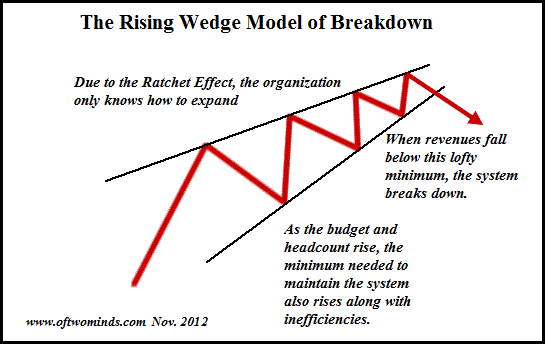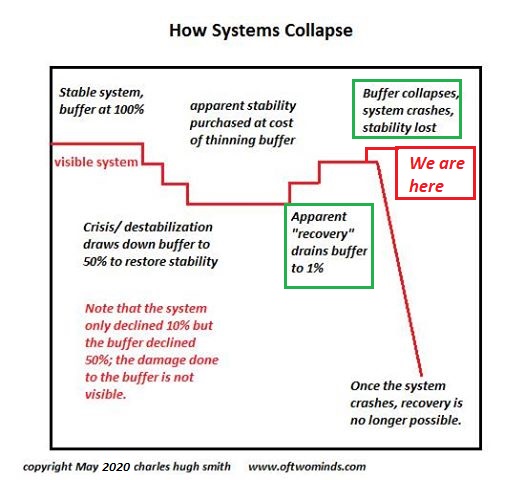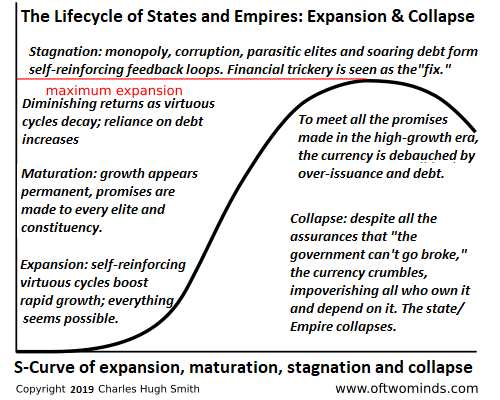
Maintaining the illusion of confidence, permanence and stability serves the interests of those benefiting from the bubbles and those who choose the security of the herd, even as the herd thunders towards the precipice.
The misunderstanding that collapse is an all or nothing phenomenon prevails: Either the system rights itself with a little bit of money-printing and rah-rah or it collapses into post-industrial destroy and gangs are fighting over the last stash of canned beans.
Neither circumstance thinks about the fragility and durability of the socio-economic system as a whole. It is both far more fragile than the followers in the permanence of the waste is growth model grasp and more resistant than the complete collapse prognosticators grasp.
The current fairly mild logjams in global supply chains of basics are simple peeks of precariously vulnerable delivery-supply systems. These can be comprehended as bottlenecks that only experts see, or as unstable nodes through which all the economy’s connections run. Put another method, the economy’s as a network appears decentralized and robust, however this impression vanishes when we consider how the whole economy rests on a couple of unstable nodes.
One such node is the shipment of gas and fuels. It’s such an effective and dependable system that 99.9% of us take it for granted: there will constantly be a lot of fuel at every station, the tanks of jet fuel will always be topped off, and so on.
The 0.1% know that this system, when interfered with, would overturn dominoes all through the economy.
Hyper-efficiency and hyper-globalization has actually minimized the number of manufacturers of important to the point that disruptions can not be overcome with redundant sources. We see this all over in the international economy: a handful of plants and companies (sometimes a single source of important components) process or manufacture essential parts in much bigger systems.
This is how you end up with countless newly made lorries parked in lots waiting for one crucial part that remains in brief supply.
Another crucial weakness is the entire system’s dependence on financial obligation, take advantage of and speculation. Couple of appear to comprehend that physical production and shipment systems can grind to a halt for monetary factors– for example, lines of credit being pulled, a counterparty to some arcane commodity swap goes under, taking the presumably solvent corporation down with it, and so on.
The more financial obligation that’s been piled up, the higher the instability of the entire system. Threat always appears low till the system destabilizes, and after that all the hedges stop working and run the risk of breaks out, flooding through the whole monetary system.
Take advantage of is terrific enjoyable en route up, as it amplifies gains. Considering That the Federal Reserve implicitly guarantees that “buy the dip” will produce huge gains, why not ramp up utilize ten-fold to make the most of those Fed-guaranteed gains?
Utilize is less fun on the way down. When the underlying security has shrunk to 20% of the leveraged bets being made, a 21% decline in the property erases all the security holding up the palace of leveraged financial obligation.
The Fed can print cash but it can’t create collateral, nor can it make insolvent entities solvent. All the Fed can do is increase the financial obligation and utilize, which is not the solution, it’s the problem.
Speculation is likewise naturally unstable, as the euphoric herd, once shocked, turns in panic and stampeded in fear. Markets which appeared liquid– i.e., sellers could count on somebody buying as numerous countless shares as they desired to offer– become illiquid, as buyers vanish like mist in Death Valley. With buyers gone, prices drop to levels the herd reckoned “difficult” simply days before.
The Fed’s whole method in the 21st century has been to pump up property bubbles that generate the illusion of wealth– the so-called wealth impact which is presumed to influence voracious loaning and spending.
Sadly for the Fed, most of the gains flowed to the leading 0.1%, and an economy based upon a handful of billionaires buying super-yachts and spaceships is a line of dominoes awaiting the inevitable “mishap.” So there are 2 systemic issues with counting on asset bubbles to produce “wealth”: 1) given that 90% of the properties are owned by a thin slice of the people, bubbles increase destabilizing inequality, and 2) bubbles are fundamentally unsteady. So the U.S. economy, dependent on the Fed for the “juice” of monetary stimulus, is now depending on extremely unstable bubbles in assets, financial obligation and take advantage of, bubbles which have created extremes of wealth/income inequality that are destabilizing the social and political orders.
As the three charts below illustrate, the fragility and instability are well concealed till it’s too late: bubbles, debt, utilize, budgets and incomes can just click higher because the system breaks down if there is any continual decrease (the increasing wedge model of breakdown). When the subsystems fail, there’s no putting the eggshell back together.
The second chart portrays how buffers thin underneath the surface area, masking the systemic fragility. The loss of redundancy, the decay of maintenance, the loss of experienced employees– all of these are hidden from public view until the system breaks down.
The third chart tracks the S-curve of expansion, self-confidence, complacency, delusion and collapse followed by human systems, from countries to empires to corporations: as the buffers thin and the increasing wedge reaches a peak of vulnerability, the management evinces a delusional self-confidence in the permanence and stability of progressively vulnerable, unsteady systems.
Keeping the impression of confidence, permanence and stability serves the interests of those taking advantage of the bubbles and those who choose the safety of the herd, even as the herd rumbles towards the precipice.
This is how breakdowns in obviously stable subsystems sets off the fall of dominoes throughout the bigger system, leading to a collapse that was commonly considered as “impossible.” Such is the power of complacency and deception.



< img align ="center"src=" https://www.oftwominds.com/photos2020/systems-collapse5-20.jpg "/ > If you discovered worth in this material, please join me in seeking solutions by becoming a $1/month patron of my work by means of patreon.com.
My brand-new book is readily available! A Hacker’s Teleology: Sharing the Wealth of Our Shrinking World 20% and 15% discount rates (Kindle $7, print $17, audiobook now available $17.46)
Read excerpts of the book free of charge (PDF).
The Story Behind the Book and the Intro.
Recent Videos/Podcasts:
AoE Beauty salon # 44: We say “Satyagraha”, they state “sedition” with author Max Borders (1:03 hrs)
My recent books:
A Hacker’s Teleology: Sharing the Wealth of Our Shrinking World (Kindle $8.95, print $20, audiobook $17.46) Read the first section for free (PDF).
Will You Be Richer or Poorer?: Revenue, Power, and AI in a Shocked World
(Kindle $5, print $10, audiobook) Check out the very first area free of charge (PDF).
Pathfinding our Fate: Preventing the Final Fall of Our Democratic Republic ($5 (Kindle), $10 (print), ( audiobook): Check out the first section for free (PDF).
The Experiences of the Consulting Philosopher: The Disappearance of Drake $1.29 (Kindle), $8.95 (print); checked out the very first chapters free of charge (PDF)
Cash and Work Unchained $6.95 (Kindle), $15 (print) Check out the first section free of charge (PDF).
End up being a $1/month client of my work through patreon.com.
KEEP IN MIND: Contributions/subscriptions are acknowledged in the order received. Your name and e-mail remain confidential and will not be offered to any other specific, business or company.
|
Thank you, Marsha B. ($54), for your fantastically generous contribution to this website– I am considerably honored by your support and readership. |
Thank you |
, Ann K. ($5/month), for your marvelously generous promise to this site– I am greatly honored by your unfaltering support and readership. |
|
Thank you, Robert S. ($5/month), for your magnificently generous pledge to this site– I am considerably honored by your unfaltering assistance and readership. |
Thank you |
, Bart N. ($54), for your splendidly generous contribution to this site– I am significantly honored by your support and readership. |

